Guidelines to Calibrate a Multi-Residential Building Simulation Model Addressing Overheating Evaluation and Residents’ Influence
Abstract
1. Introduction
2. Methods
2.1. Building Properties
2.2. Indoor Measurements
- 1st floor/ground floor: Study room (east) and living room (west)
- 2nd floor: Children room (east) and sleeping room (west)
- 4th floor: Bedroom (east) and kitchen-living room (west)
- 5th floor/attic: both dwellings each with bedroom (east) and kitchen-living room (west)
2.3. Local Meteorological Data
2.4. Building Performance Simulation
- Location of the building is Erfurt, Germany
- Orientation of the building similar to reality (east-side façade oriented to the street, west-side oriented to the backyard)
- Shading objects on the GZH building were taken into account, e.g., the building on the opposite side of the street (east façade), balconies on the west-side façade as well as shading of trees on the street-side, and in the backyard (cf. Figure 1c).
- Sun protection systems: For the actual GZH building, no external sun protection systems are present, and thus considered.
- Thermal bridges: Overall thermal bridge loss coefficient of 0.10 W/(m2K) is related to all component surfaces according to DIN 18599-2 for existing buildings without internal insulation [30].
- Internal loads: The daily time series of the initial internal heat loads for the investigated ten rooms and the internal loads for all (neighboring) rooms (set for all simulation variants) are depicted in Figure A1 of the Appendix A. The presence and number of occupants for the dwellings were derived from a residents’ survey conducted in the selected GZH buildings and answered by the residents of five of eight dwellings. In this survey, the following issues have been asked: number and age of residents, common presence of occupants during a day, the kind and use of window shadings (curtains and for the top floor dwellings awnings for the western-faced rooms; external sun protection systems are not installed), if nocturnal window ventilation is commonly applied as well as cross ventilation. Because of privacy protection, the operation of electrical devices in the dwellings could not be monitored. However, the results of the survey showed, that most residents are median age living together with 1–2 children and work apart during the day, although not all surveys were answered entirely. The derived internal heat gain profiles are only rough assumptions because room uses vary individually for different dwellings. The impacts of internal heat gains on overheating intensity of rooms are discussed in the sensitivity analysis.
- Air exchange (window opening and infiltration) by wind and temperature gradient is included in the BPS software IDA ICE; to gain high accordance between measured and simulated room temperatures, the air exchange of rooms caused by window ventilation and infiltration driven by wind and temperature gradients must be represented as realistically as possible for the calibration by BPS. IDA ICE enables this opportunity to take into account wind flows through a building by considering pressure coefficient of the individual façade and roof elements. Thus, wind-driven interzonal air exchanges in the building as well as cross ventilation by opening room doors can be considered in BPS. Besides these wind-driven air flows, temperature gradient driven air exchange by different indoor to outdoor or adjacent room temperatures is considered as well. The wind and temperature gradient driven infiltration is calculated by IDA ICE by defining an n50 (air exchange rate at 50 Pa pressure coefficient) value of 2 h−1 (according to DIN EN 15242 for average leakages) as a measure of air tightness for the GZH building. A more detailed description of the air exchange algorithm can be found in the Appendix A (“multizonal air exchange calculation in IDA ICE”).
- Window openings for all rooms in the GZH building (except the individual investigated ten monitored rooms) are defined as follows:
- ○
- Window opening control: windows opened when the outdoor air is cooler than the room air, and the room air > 22 °C (depending on the window opening schedule)
- ○
- Window opening schedule: windows are fully opened from 6 p.m. to 10 p.m. and 6 a.m. to 7 a.m.; tilted during the night from 10 p.m. to 6 a.m.
- ○
- Degree of window opening: taken from measurements of the existing opening area of the installed windows
- ○
- All room doors remain closed
2.5. Overheating Criteria
3. Results and Analysis
3.1. Monitoring Results
3.2. Simulation Adjustment in the Absence of Residents
- The first variant represents the initial simulation run without implementation of any internal gains or internal sun protection and with closed windows or room doors. The simulated temporal development of temperature run fairly parallel to the measured ones, but for most rooms with stronger variations within the day.
- In the second variant internal solar shading via the use of curtains (reduction factor of solar gain Fc = 0.7) was applied for most rooms, as well as constant internal heat gain by electrical devices to achieve better conformity with the measured room temperature. The measured temperature time series in the kitchen-living room of the attic dwelling can only be matched if the awning, installed by the tenants on top of the huge window front, is extended and shades the room.
- In the third variant, final calibration of the simulation model was conducted by implementing the effect of open room doors. Especially for the study room in the 1st floor, a remarkable impact of air exchange can be observed as caused by the small room size combined with high solar and internal heat gains.
3.3. Simulation Adjustment Including Residents’ Behavior
3.4. Sensitivity of Overheating
- (a)
- Meteorological data input:
- (b)
- Surrounding shading objects (buildings, trees, balconies):
- (c)
- Room use (quarantine scenario):
- (d)
- Window ventilation behavior:
- (e)
- Sun protection:
4. Discussion
4.1. Conformity of Simulated to Monitored Room Temperatures
4.2. Impact of Residents on Overheating
4.3. Guideline for Simulation Model Calibration of Multi-Residential Buildings Addressing Overheating Evaluation
- (a)
- the building must already exist because calibration requires monitoring data from the building,
- (b)
- availability of detailed construction data of the investigated building,
- (c)
- a reliable BPS programs that implements for wind and temperature gradient driven air flow network,
- (d)
- representative meteorological data in the surrounding of the building as input for BPS (verified meteorological stations are commonly located outside the city and seldom record required direct and diffuse solar irradiation),
- (e)
- representative time-resolved (at least one hour resolved) user profiles including presence of residents, internal heat gain, and most importantly window ventilation profiles. Available standardized profiles do not ensure the required time resolution [32] or contain profiles which seem to be unrealistic in their temporal evolution [21,34]. Most suitable and critical (due to privacy protection) would be a detailed monitoring of the resident behavior or at least detailed surveys of their behavior.
4.4. Caveats and Study Limitations
- (1)
- The required meteorological conditions for BPS could not be recorded within close proximity to the GZH building. The solar irradiance used for simulation was recorded in 40 km distance to the GZH building leading to deviations of solar heat gain especially for days with variable cloudiness. The used wind data, recorded at an exposed field also differs to wind conditions present at the façade of the building as well as the recorded outdoor air temperature nearby. However, the proof that the chosen meteorological conditions are suitable, is given by the good conformity of simulated to measured room temperatures. In addition, it should be mentioned that the summer 2019 was not a representative summer for the location of Erfurt, but one of the hottest since recording. Thus, ODH values might not represent overheating intensities for an actual representative summer, but probably for a summer projected in a few decades.
- (2)
- The internal heat gains by occupancy, equipment, and light of the simulated rooms were only assumed by questionnaires, and could not be verified by detailed monitoring due to privacy protection.
- (3)
- The window ventilation and room door opening profiles of the individual rooms was determined by the calibration of simulated to measured room temperatures. Measurements via window contacts would have been advantageous, but again not possibly caused by privacy protection issues. The notion that the air exchange is reproduced in a realistic manner was proven for a dwelling in another GZH building, where window and door opening as well as internal heat gain profiles were monitored. For this dwelling, a good agreement of measured and simulated room temperatures could be achieved, confirming the air exchange algorithm used in IDA ICE.
- (4)
- For all simulation variants, the window opening profile and internal heat gains of not monitored rooms were set to room use dependent values presented in Section 2.4. From those not-monitored rooms, heat exchange can occur by transmittance through ceiling and internal walls to the monitored rooms. Therefore, the gained values of equipment load (cf. Figure 5 and Figure A3) shall be interpreted with caution, because they can partly also be traced back to different transmission from neighboring rooms. However, testing the influence by varying the heat load and window opening behavior showed that the error is in the range of 10% of the ODH values in Table 3.
- (5)
- BPS is a complex process, including a high number of parameters, and an intermixing of building physics and occupant behavior. This can lead to calibrated simulations showing good conformity to measured values but do not represent the parameters in reality, properly. This can especially occur when focusing on the calibration for single days, where a room temperature increase can be evoked by different effects such as internal heat gain, solar heat gain, window ventilation or room door opening. A sensitivity analysis of insecure parameters (like user behavior) is vital to reduce this threat. In the present calibration study, only a few parameters, mainly room door opening, window opening, shading and internal heat gain, are found to be the most sensitive parameters for the evolving simulated room temperature. For a higher number of insecure parameters, our proposed method of individual fitting can lead to misinterpretation because interactions of parameters, non-linear and high order effects might occur. For such circumstances, other methods can be more suitable to calibrate models without individual fitting procedures, like Bayesian calibration or alternative big-data-driven simulation methods like black-box and grey-box models [39,40,41].
- (6)
- The thermal comfort does not only depend on room temperatures but also on other factors like air humidity and heat radiation. In the present study, we only focus on the comparison of monitored and simulated room temperature profiles. An extension to implement the effect of humidity and heat radiation will be appropriate to implement in the future, to gain a more reliable evidence on overheating intensity then use the overheating degree hours, only based on the room temperature.
- (7)
- For the performed condensed sensitivity analysis, only one parameter was changed at a time, and thus interactions, non-linear and high order effects are not included.
5. Conclusions
- (a)
- the usage of regional meteorological data for wind, air temperature, and solar irradiance in close proximity to the investigated building
- (b)
- generating an accurate 3D thermal simulation model of the building, taking detailed information on building components, and the shading situation by surrounding objects into account for all rooms
- (c)
- a BPS tool with an implemented wind and temperature gradient driven air exchange algorithm
- (d)
- considering a suitable and realistic individual room use behavior of the residents, regarding heat gain, and especially window and room door opening profiles. Here, the use of residents’ surveys is recommended to collect this information as precisely as possible.
Author Contributions
Funding
Institutional Review Board Statement
Informed Consent Statement
Data Availability Statement
Acknowledgments
Conflicts of Interest
Appendix A
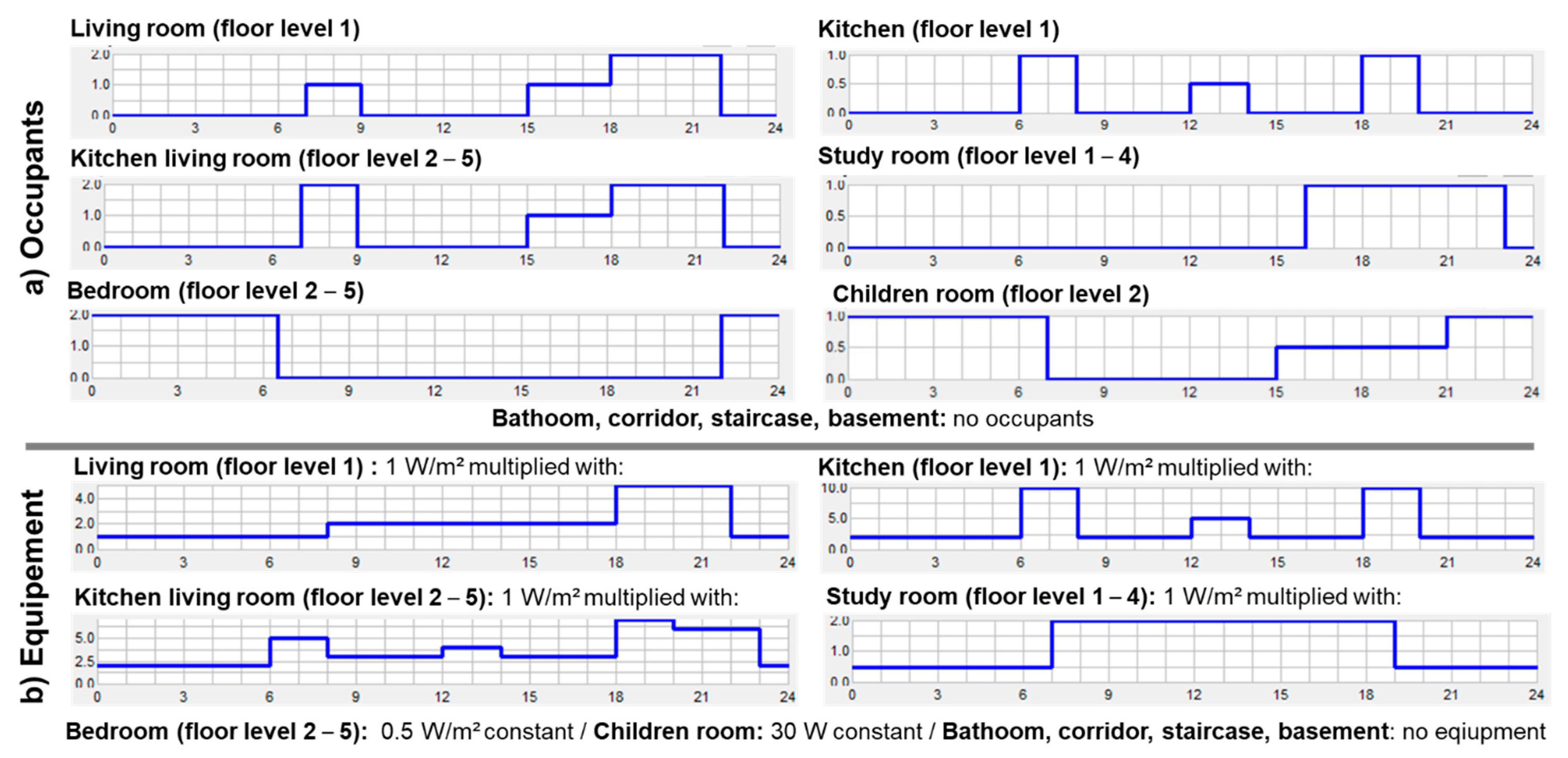
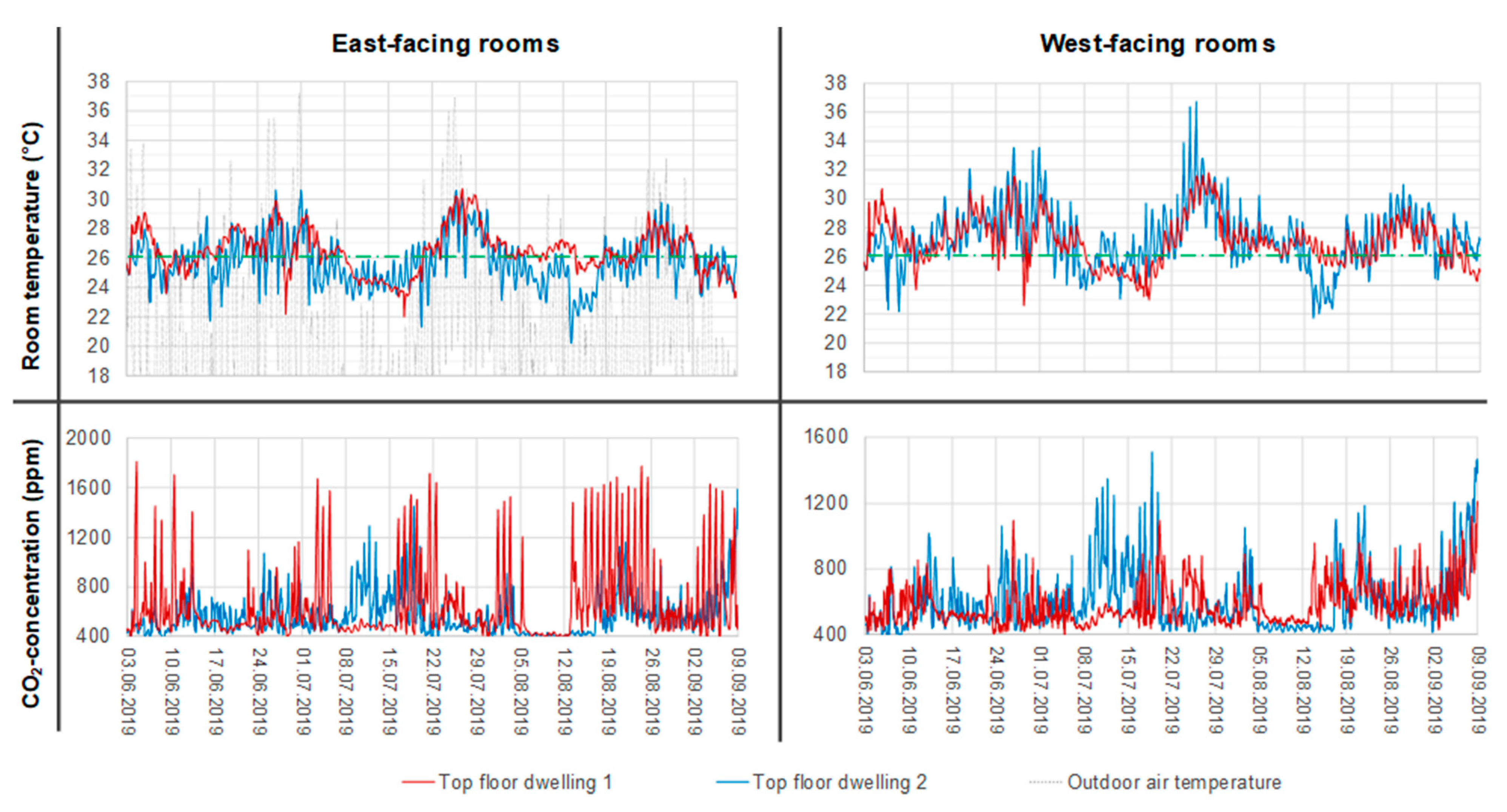
| Standard Scenario | Quarantine Scenario | |
|---|---|---|
| (a) Kitchen-living room (west-facing facade) | ||
| Window opening | no | tilted from 7 a.m. to 10 p.m. (for fresh air supply) |
| Occupants | Standard (see Figure A1: kitchen-living room) | 1.5 (mean) persons present from 7 a.m. to 10 p.m. |
| Equipment | 50 W constant | 100 W constant |
| (b) Bedroom (east-facing facade) | ||
| Window opening | Both windows tilted from 6 p.m. to 9 a.m. | One window tilted from 6 p.m. to 9 a.m.; Second window always tilted (for fresh air supply) |
| Room door opening | Always open | Door closed from 7 a.m. to 8 p.m. |
| Occupants | Standard (see Figure A1: bedroom) | According to timetable: |
| Equipment | no | 150 W from 7 a.m. to 8 p.m. |
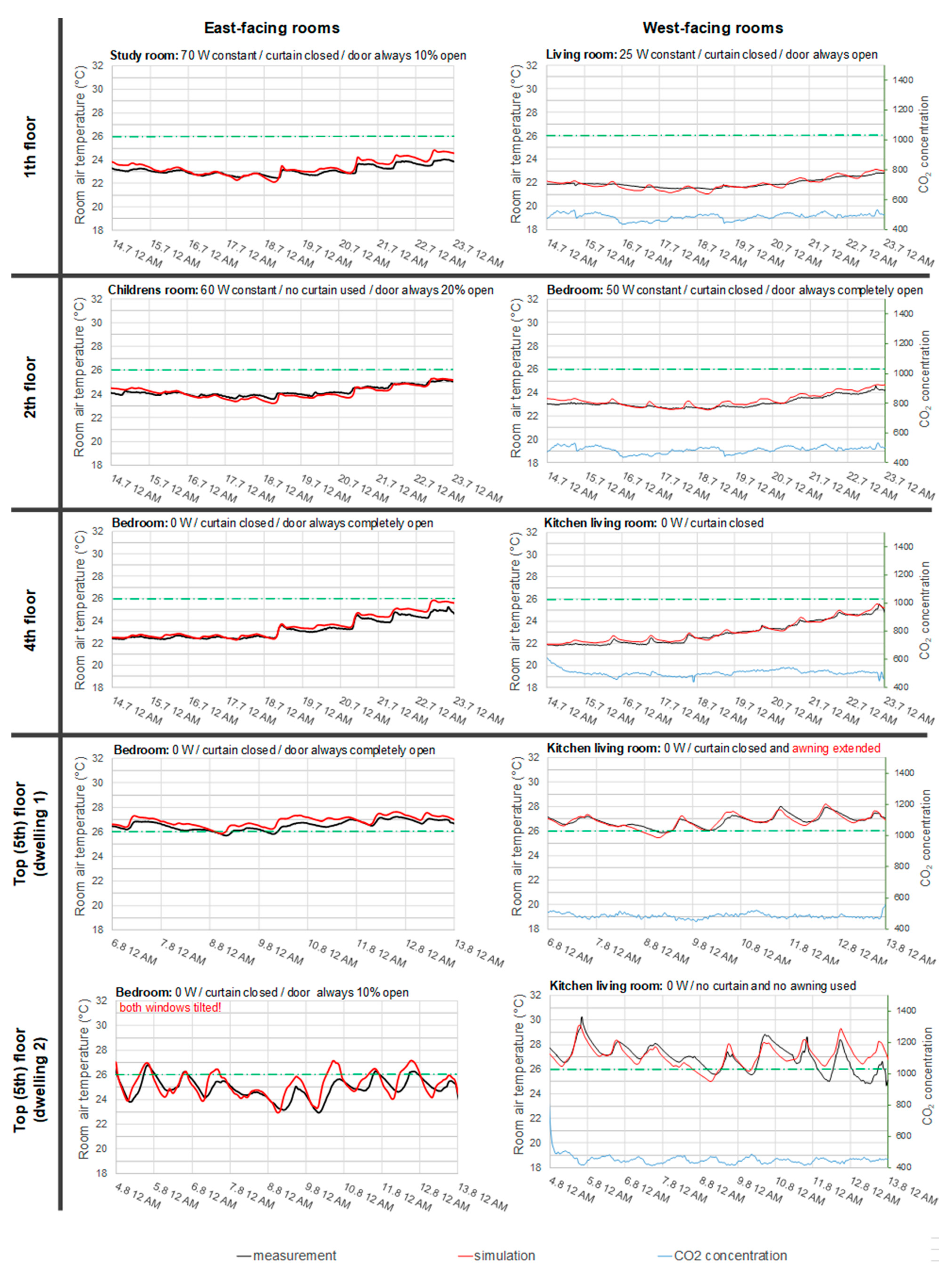
| Floor Level | East-Facing Rooms | West-Facing Rooms ** | ||
|---|---|---|---|---|
| Standard Ventilation (as Observed in Reality) | Optimised Night-Time Ventilation | Standard Ventilation (as Observed in Reality) | Optimised Night-Time Ventilation | |
| 5th *** | W fully open overnight */ D closed | W tilted overnight */ D always open | W tilted overnight * & fully open 1 h at 7 a.m. | W never open |
| 5th **** | W fully open overnight */ D closed | Two window wings fully open overnight */ D always open | W tilted overnight * & fully open 1 h at 7 a.m. | W never open |
| 4th | W fully open overnight */ D closed | W tilted overnight */ D always 20% open | Large W fully open 1 h at 7 a.m./ Small W tilted overnight * & fully open 1 h at 7 a.m. | Large W closed, small W tilted overnight * |
| 1st | W fully open 1 h at 7 a.m./ D closed | W closed/ D always 20% open | Both W fully open 1 h at 7 a.m. | W 15 min open at 8 am and 8 p.m. |
| Thickness (mm) | Heat Conductivity (W/m*K) | Density (kg/m3) | Heat Capacity J/(kg*K) | |
|---|---|---|---|---|
| Wooden beam ceiling | ||||
| flooring | 5 | 0.2 | 700 | 1500 |
| dry screed | 20 | 0.32 | 1150 | 1100 |
| footstep sound insulation | 10 | 0.04 | 20 | 1200 |
| wood | 20 | 0.14 | 500 | 2300 |
| air | 20 | 0.17 | 1.2 | 1006 |
| sand&beam | 80 | 2 | 2000 | 1000 |
| wood | 20 | 0.14 | 500 | 2300 |
| air | 30 | 0.17 | 1.2 | 1006 |
| wood | 20 | 0.14 | 500 | 2300 |
| air | 30 | 0.17 | 1.2 | 1006 |
| gypsum board | 25 | 0.25 | 680 | 960 |
| Basement ceiling | ||||
| flooring | 5 | 0.2 | 700 | 1500 |
| footstep sound insulation | 5 | 0.04 | 20 | 1200 |
| screed | 50 | 1.7 | 2300 | 880 |
| insulation | 60 | 0.04 | 20 | 1200 |
| light concrete | 150 | 1.4 | 2300 | 880 |
| Saddle roof | ||||
| roof tiles | 0.58 | 1500 | 800 | |
| wood | 20 | 0.14 | 500 | 2300 |
| mineral wool & beam | 160 | 0.04 | 300 | 1400 |
| air | 30 | 0.17 | 1.2 | 1006 |
| gypsum board | 25 | 0.25 | 680 | 960 |
| Brick walls | ||||
| render | 15 | 0.8 | 1800 | 790 |
| brick | 280/380/510 | 0.52 | 1200 | 840 |
| render | 15 | 0.8 | 1800 | 790 |
| Dry walls | ||||
| gypsum board | 25 | 0.25 | 680 | 960 |
| insulation | 50 | 0.04 | 20 | 750 |
| gypsum board | 25 | 0.25 | 680 | 960 |
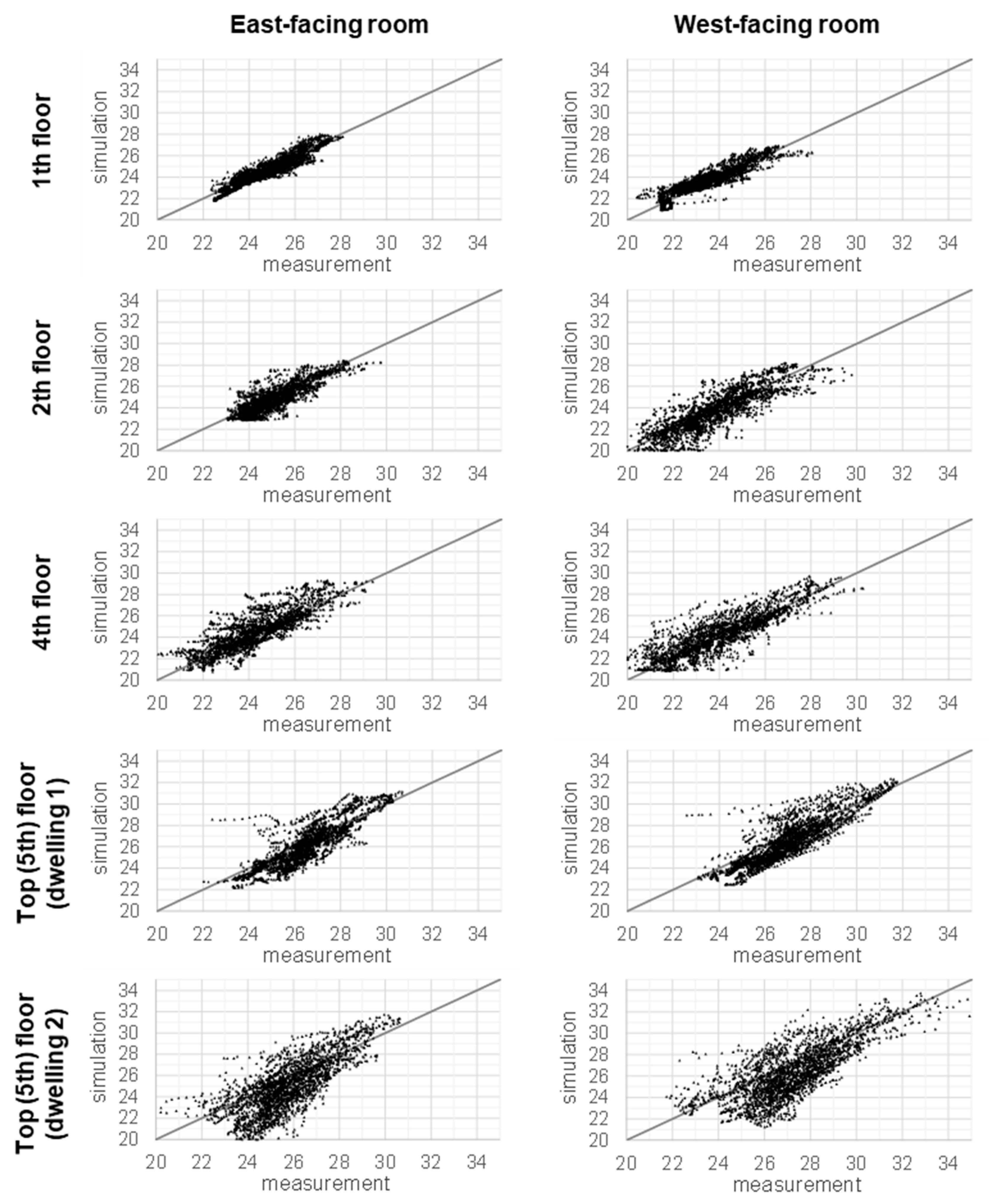
Multizonal Air Exchange Calculation in IDA ICE
References
- IPCC. IPCC-Report AR5 Climate Change 2014: Impacts, Adaptation, and Vulnerability—Part B Regional Aspects (Intergovernmental Panel on Climate Change); IPCC: Geneva, Switzerland, 2014. [Google Scholar]
- Head, K.; Clarke, M.; Bailey, M.; Livinski, A.; Ludolph, R.; Singh, A. Report of the Systematic Review on the Effect of Indoor Heat on Health (WHO Housing and Health Guidelines—Web Annex D); WHO-World Health Organization: Geneva, Switzerland, 2018. [Google Scholar]
- Kershaw, T.J.; Sanderson, M.; Coley, D.; Eames, M. Estimation of the urban heat island for UK climate change projections. Build. Serv. Eng. Res. Technol. 2010, 31, 251–263. [Google Scholar] [CrossRef]
- Chen, D. Overheating in residential buildings: Challenges and opportunities. Indoor Built Environ. 2019, 28, 1303–1306. [Google Scholar] [CrossRef]
- Chvatal, K.M.S.; Corvacho, H. The impact of increasing the building envelope insulation upon the risk of overheating in summer and an increased energy consumption. J. Build. Perform. Simul. 2009, 2, 267–282. [Google Scholar] [CrossRef]
- Fosas, D.; Coley, D.A.; Natarajan, S.; Herrera, M.; de Pando, M.F.; Ramallo-Gonzalez, A. Mitigation versus adaptation: Does insulating dwellings increase overheating risk? Build. Environ. 2018, 143, 740–759. [Google Scholar] [CrossRef]
- Hamdy, M.; Carlucci, S.; Hoes, P.-J.; Hensen, J.L. The impact of climate change on the overheating risk in dwellings—A Dutch case study. Build. Environ. 2017, 122, 307–323. [Google Scholar] [CrossRef]
- Jenkins, D.; Patidar, S.; Banfill, P.; Gibson, G. Probabilistic climate projections with dynamic building simulation: Predicting overheating in dwellings. Energy Build. 2011, 43, 1723–1731. [Google Scholar] [CrossRef]
- Mulville, M.; Stravoravdis, S. The impact of regulations on overheating risk in dwellings. Build. Res. Inf. 2016, 44, 520–534. [Google Scholar] [CrossRef]
- Porritt, S.M.; Shao, L.; Cropper, P.; Goodier, C. Occupancy Patterns and Their Effect on Interventions to Reduce Overheating in Dwellings during Heat Waves. In Proceedings of the Conference: Adapting to Change: New Thinking on Comfort, Windsor, UK, 9–11 April 2010. [Google Scholar]
- Soutullo, S.; Giancola, E.; Jiménez, M.J.; Ferrer, J.A.; Sánchez, M.N. How Climate Trends Impact on the Thermal Performance of a Typical Residential Building in Madrid. Energies 2020, 13, 237. [Google Scholar] [CrossRef]
- Giancola, E.; Soutullo, S.; Olmedo, R.; Heras, M. Evaluating rehabilitation of the social housing envelope: Experimental assessment of thermal indoor improvements during actual operating conditions in dry hot climate, a case study. Energy Build. 2014, 75, 264–271. [Google Scholar] [CrossRef]
- Petrou, G.; Symonds, P.; Mavrogianni, A.; Mylona, A.; Davies, M. The summer indoor temperatures of the English housing stock: Exploring the influence of dwelling and household characteristics. Build. Serv. Eng. Res. Technol. 2019, 40, 492–511. [Google Scholar] [CrossRef]
- Tink, V.; Porritt, S.; Allinson, D.; Loveday, D. Measuring and mitigating overheating risk in solid wall dwellings retrofitted with internal wall insulation. Build. Environ. 2018, 141, 247–261. [Google Scholar] [CrossRef]
- Vellei, M.; Gonzalez, A.R.; Kaleli, D.; Lee, J.; Natarajan, S. Investigating the overheating risk in refurbished social housing. In Proceedings of the 9th Windsor Conference: Making Comfort Relevant, Cumberland Lodge, Windsor, UK, 7–10 April 2016. [Google Scholar]
- Adekunle, T.O.; Nikolopoulou, M. Thermal comfort, summertime temperatures and overheating in prefabricated timber housing. Build. Environ. 2016, 103, 21–35. [Google Scholar] [CrossRef]
- Mavrogianni, A.; Pathan, A.; Oikonomou, E.; Biddulph, P.; Symonds, P.; Davies, M. Inhabitant actions and summer overheating risk in London dwellings. Build. Res. Inf. 2016, 45, 119–142. [Google Scholar] [CrossRef]
- Mavrogianni, A.; Taylor, J.; Davies, M.; Thoua, C.; Kolm-Murray, J. Urban social housing resilience to excess summer heat. Build. Res. Inf. 2015, 43, 316–333. [Google Scholar] [CrossRef]
- McLeod, R.S.; Swainson, M. Chronic overheating in low carbon urban developments in a temperate climate. Renew. Sustain. Energy Rev. 2017, 74, 201–220. [Google Scholar] [CrossRef]
- McLeod, R.S.; Swainson, M.; Hopfe, C.J.; Mourkos, K.; Goodier, C. The importance of infiltration pathways in assessing and modelling overheating risks in multi-residential buildings. Build. Serv. Eng. Res. Technol. 2020, 41, 261–279. [Google Scholar] [CrossRef]
- Mourkos, K.; Hopfe, C.J.; McLeod, R.S.; Goodier, C.; Swainson, M. The impact of accurately modelling corridor thermodynamics in the overheating risk assessment of multi-residential dwellings. Energy Build. 2020, 224, 110302. [Google Scholar] [CrossRef]
- Mourkos, K.; McLeod, R.S.; Hopfe, C.J.; Goodier, C.; Swainson, M. Assessing the application and limitations of a standardised overheating risk-assessment methodology in a real-world context. Build. Environ. 2020, 181, 107070. [Google Scholar] [CrossRef]
- Roberts, B.M.; Allinson, D.; Diamond, S.; Abel, B.; Das Bhaumik, C.; Khatami, N.; Lomas, K.J. Predictions of summertime overheating: Comparison of dynamic thermal models and measurements in synthetically occupied test houses. Build. Serv. Eng. Res. Technol. 2019, 40, 512–552. [Google Scholar] [CrossRef]
- Yan, D.; O’Brien, W.; Hong, T.; Feng, X.; Gunay, H.B.; Tahmasebi, F.; Mahdavi, A. Occupant behavior modeling for building performance simulation: Current state and future challenges. Energy Build. 2015, 107, 264–278. [Google Scholar] [CrossRef]
- Manoli, G.; Fatichi, S.; Schläpfer, M.; Yu, K.; Crowther, T.W.; Meili, N.; Burlando, P.; Katul, G.G.; Bou-Zeid, E. Magnitude of urban heat islands largely explained by climate and population. Nat. Cell Biol. 2019, 573, 55–60. [Google Scholar] [CrossRef]
- DWD. Climate Data Center DWD. 2020. Available online: https://www.dwd.de/DE/klimaumwelt/cdc/cdc_node.html (accessed on 10 May 2020).
- TLUG1. 2020. Available online: http://www.tlug-jena.de/luftaktuell/ls_messdaten.php?size=-4&mo_id=62620968 (accessed on 15 June 2020).
- TLUG2. 2020. Available online: http://webs.idu.de/wetter/?site=meteosens?station=Jena_TLUG_DS (accessed on 15 June 2020).
- EQUA. IDA Indoor Climate and Energy 4.8 SP1; EQUA Simulation AB: Stockholm, Sweden, 2018. [Google Scholar]
- DINV18599. DIN V 18599—Energetische Bewertung von Gebäuden (German Institute for Standardization); Beuth Verlag GmbH: Berlin, Germany, 2011. [Google Scholar]
- Schünemann, C.; Olfert, A.; Schiela, D.; Gruhler, K.; Ortlepp, R. Mitigation and adaptation in multifamily housing: Overheating and climate justice. Build. Cities 2020, 1, 36–55. [Google Scholar] [CrossRef]
- DIN4108. DIN 4108-2 Wärmeschutz und Energie-Einsparung in Gebäuden Teil 2: Mindestanforderungen an den Wärmeschutz (German Institute for Standardization); Beuth Verlag GmbH: Berlin, Germany, 2013. [Google Scholar]
- DIN EN 15251-2012: Indoor Environmental Input Parameters for Design and Assessment of Energy Performance of Buildings Addressing Indoor air Quality, Thermal Environment, Lighting and Acoustics; Technical Committee CEN/TC 156: London, UK, 2012.
- CIBSE. Design Methodology for the Assessment of Overheating Risk in Homes (CIBSE TM59: 2017); The Chartered Institution of Building Services Engineers London: London, UK, 2017. [Google Scholar]
- Lomas, K.J.; Porritt, S.M. Overheating in buildings: Lessons from research. Build. Res. Inf. 2016, 45, 1–18. [Google Scholar] [CrossRef]
- Schünemann, C.; Ziemann, A.; Goldberg, V.; Ortlepp, R. Urban climate impact on indoor overheating—A model chain approach from urban climate to thermal building simulation. In Proceedings of the 26th International Sustainable Development Research Society, Budapest, Hungary, 15–17 July 2020; pp. 723–734, ISBN 978-963-421-812-8. [Google Scholar]
- Fabi, V.; Andersen, R.V.; Corgnati, S.; Olesen, B.W. Occupants’ window opening behaviour: A literature review of factors influencing occupant behaviour and models. Build. Environ. 2012, 58, 188–198. [Google Scholar] [CrossRef]
- Baborska-Narożny, M.; Stevenson, F.; Grudzińska, M. Overheating in retrofitted flats: Occupant practices, learning and interventions. Build. Res. Inf. 2017, 45, 40–59. [Google Scholar] [CrossRef]
- Li, J.; Yu, Z.; Haghighat, F.; Zhang, G. Development and improvement of occupant behavior models towards realistic building performance simulation: A review. Sustain. Cities Soc. 2019, 50, 101685. [Google Scholar] [CrossRef]
- Papadopoulos, S.; Azar, E. Integrating building performance simulation in agent-based modeling using regression surrogate models: A novel human-in-the-loop energy modeling approach. Energy Build. 2016, 128, 214–223. [Google Scholar] [CrossRef]
- Riddle, M.; Muehleisen, R.T. A Guide to Bayesian Calibration of Building Energy Models. In Proceedings of the SHRAE/IBPSA-USA Building Simulation Conference, Atlanta, GA, USA, 10–12 September 2014. [Google Scholar]
- Feustel, H.E. COMIS—An international multizone air-flow and contaminant transport model. Energy Build. 1999, 30, 3–18. [Google Scholar] [CrossRef]
- Warren, P. Technical Synthesis Report IEA ECBCS Annex 23: Multizone Air Flow Modelling (COMIS); International Energy Agency: Paris, France, 1992. [Google Scholar]
- Hensen, J.L.M. On the Thermal Interaction of Building Structure and Heating and Ventilating System; University of Strathclyde: Glasgow, UK, 1991. [Google Scholar]
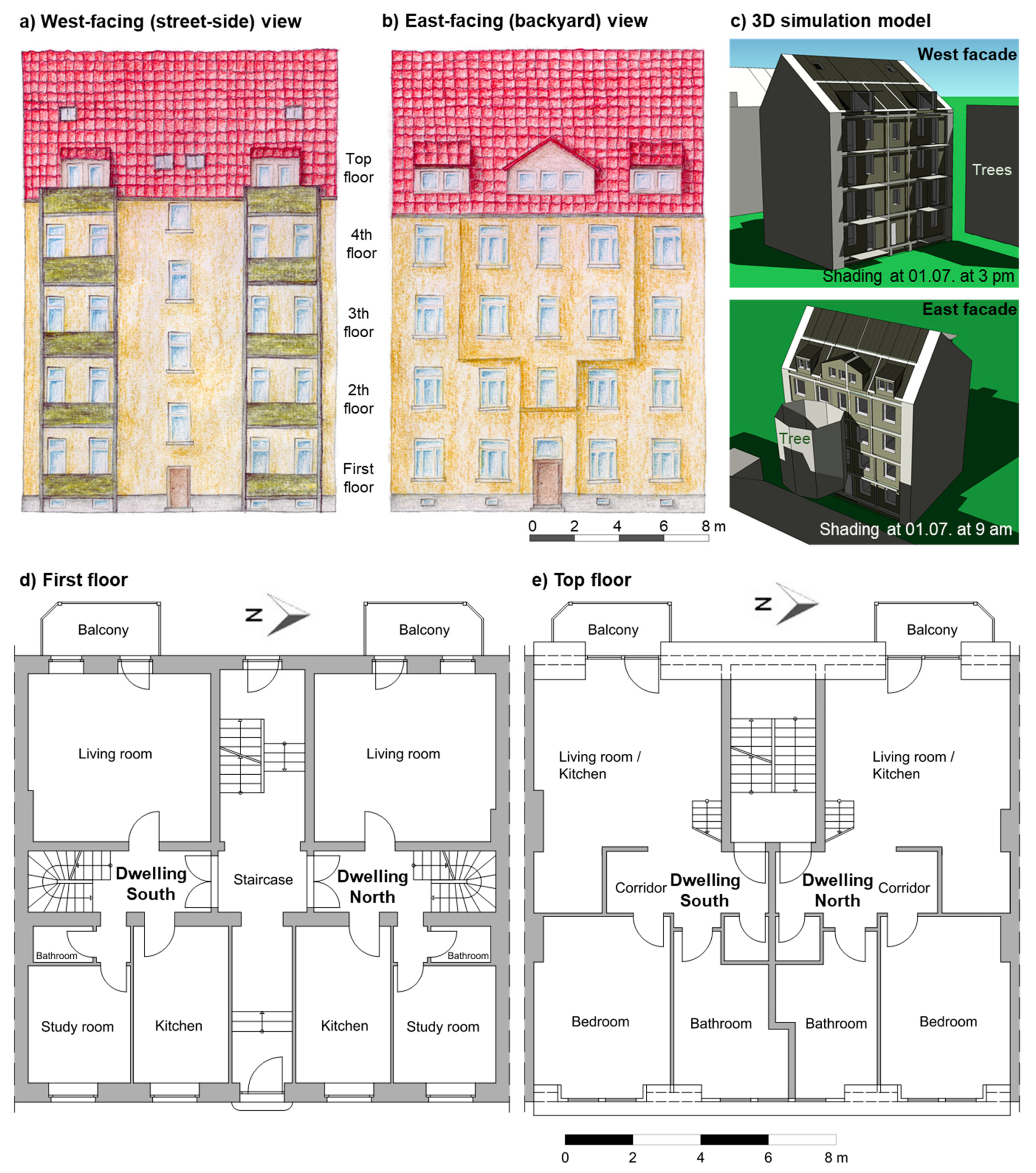

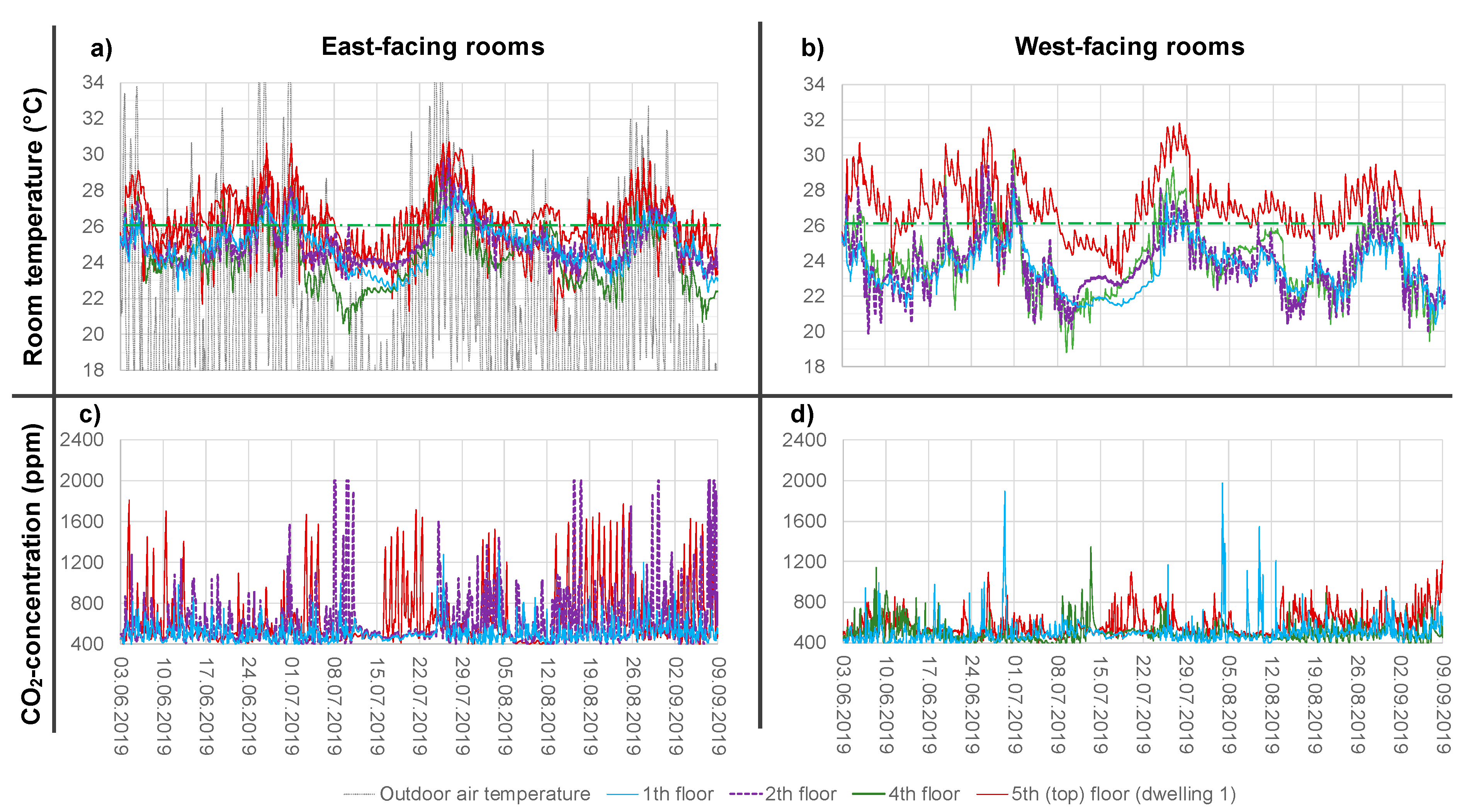
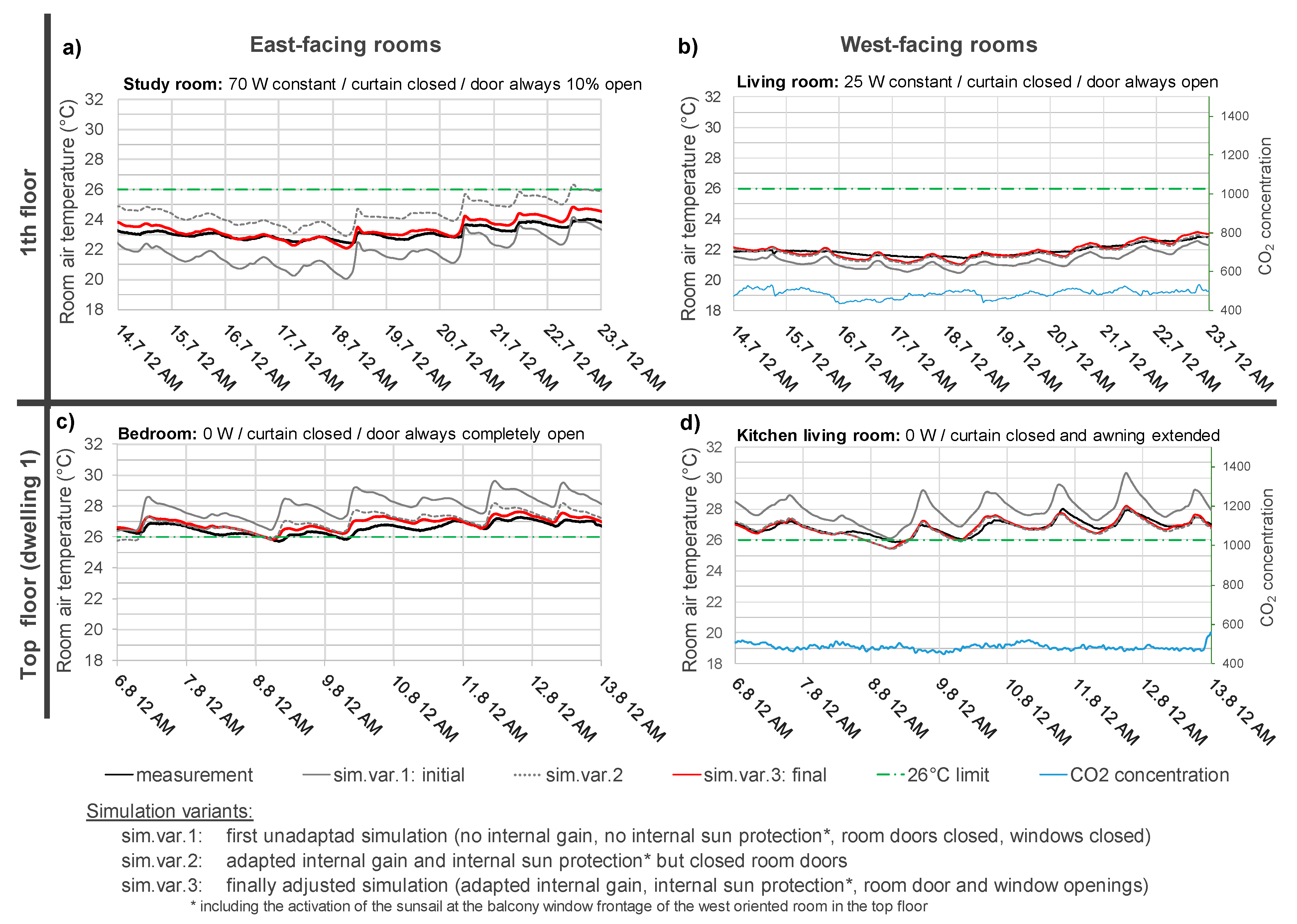
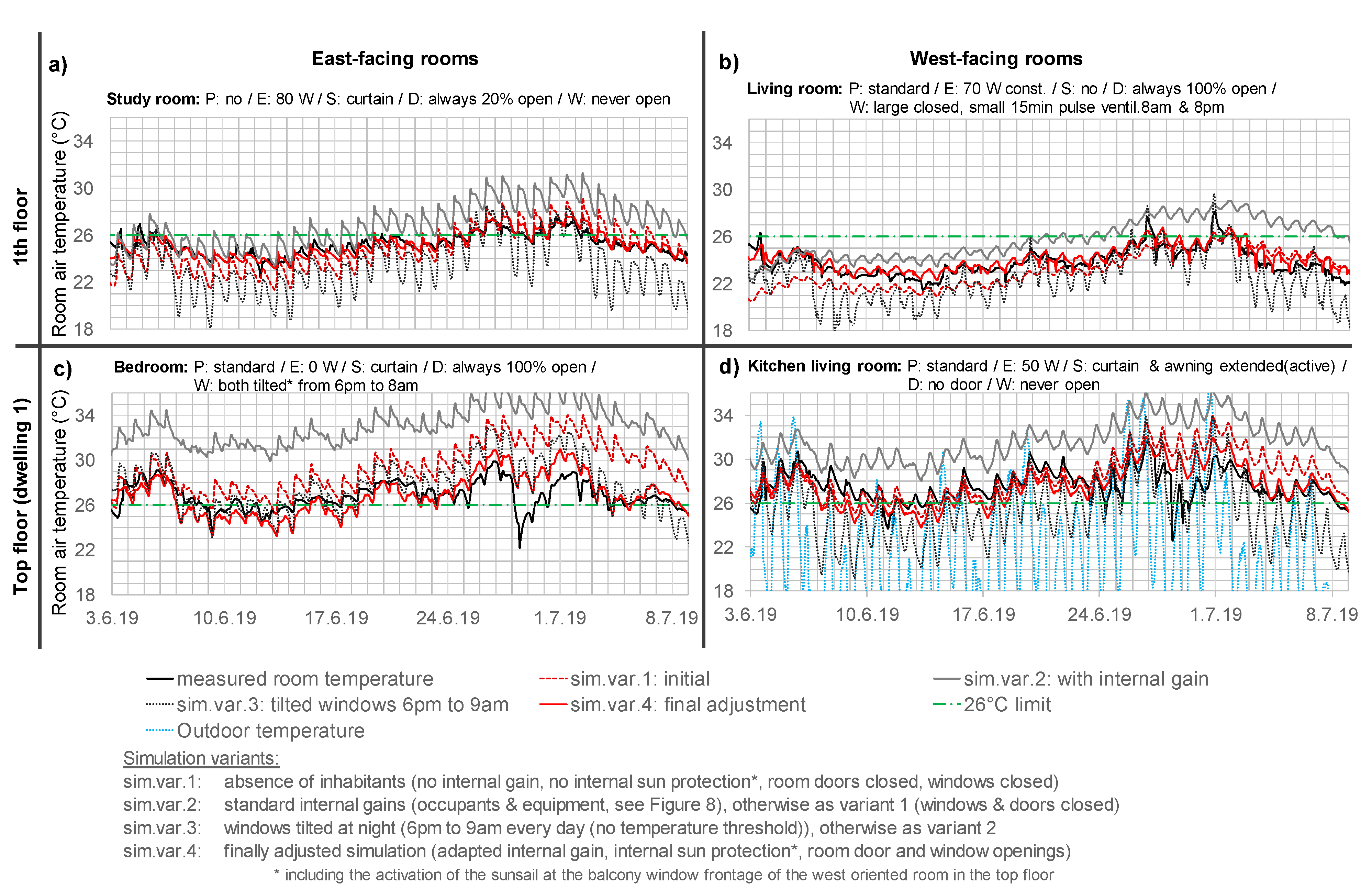
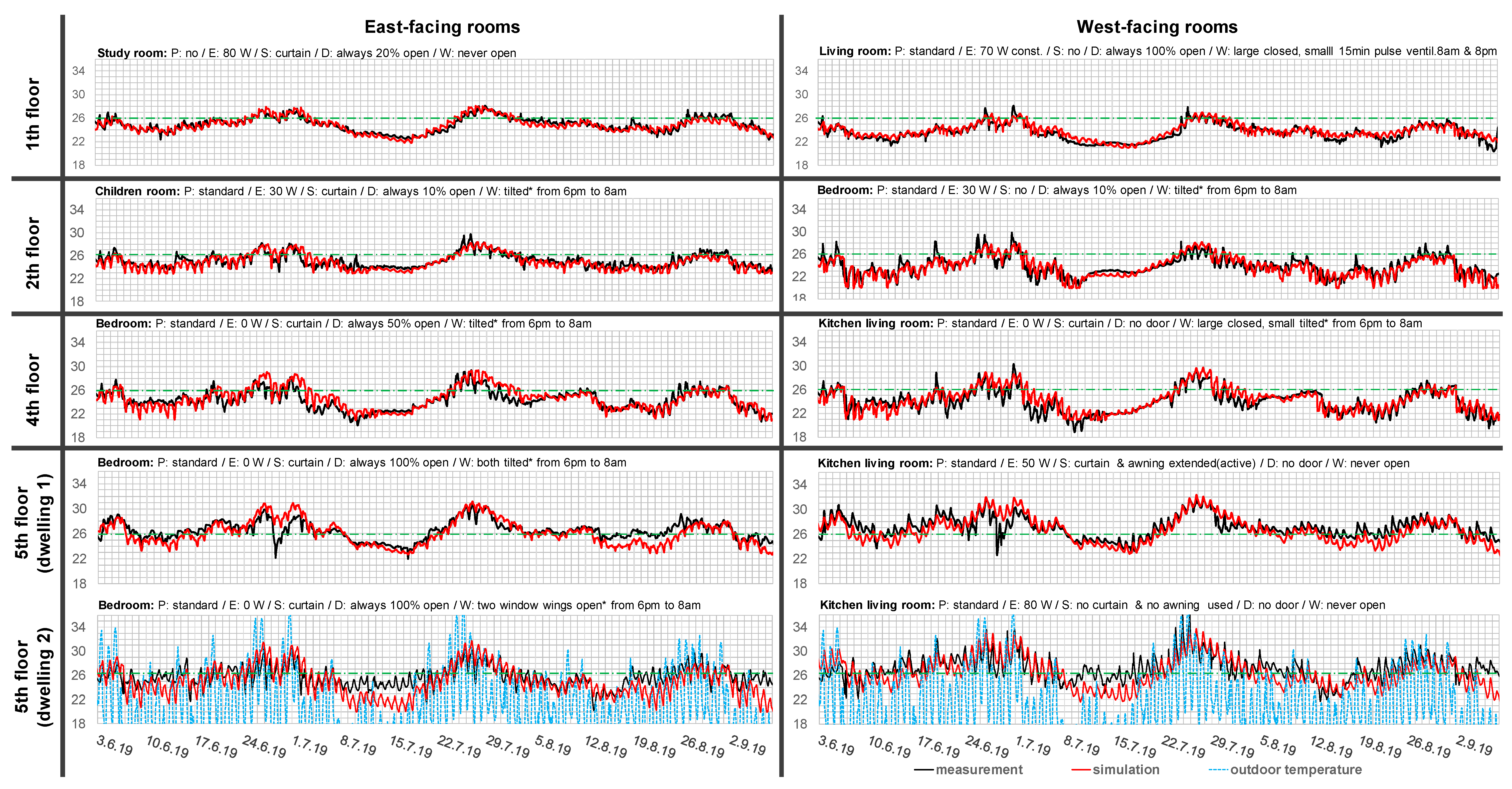
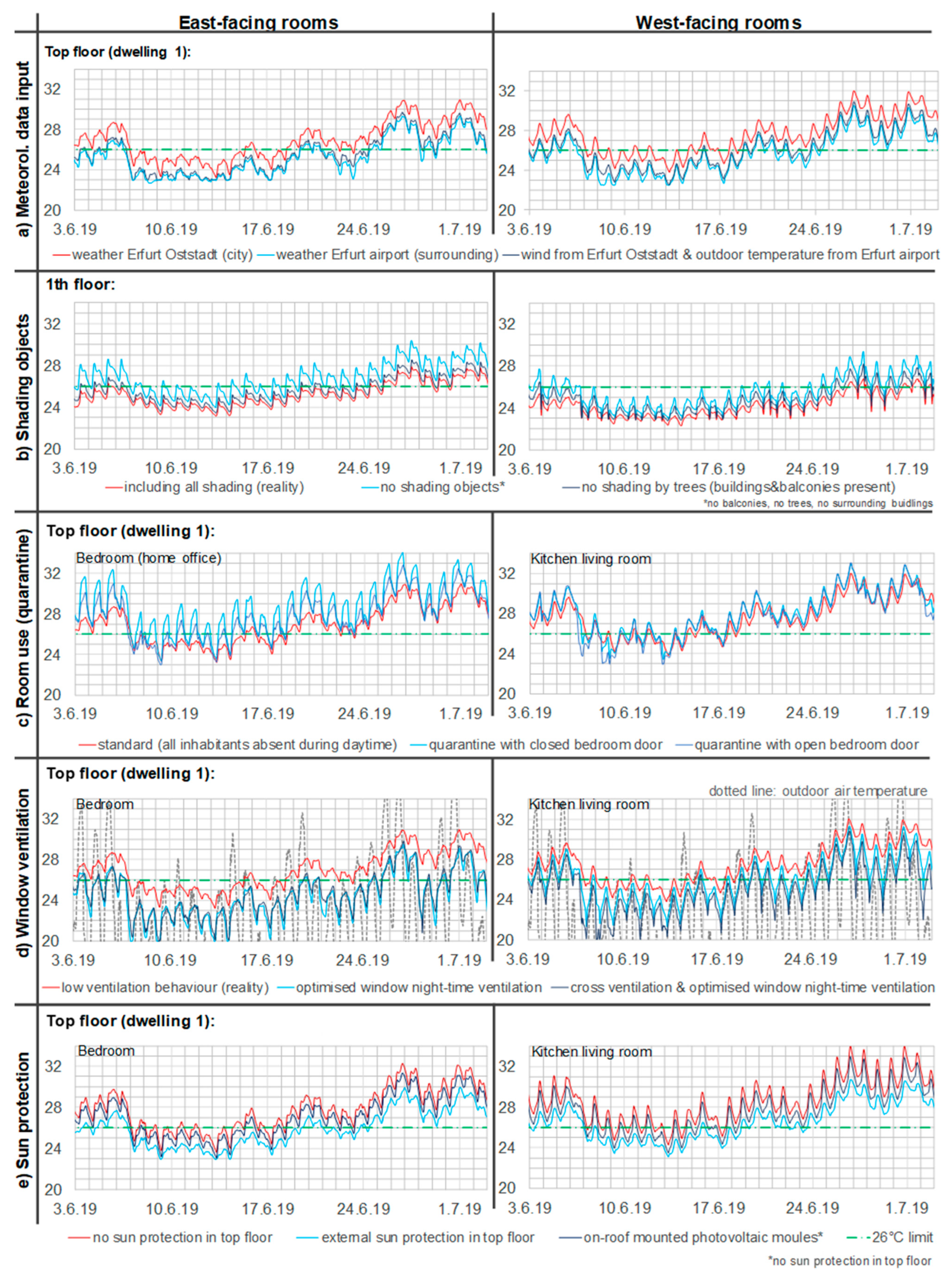
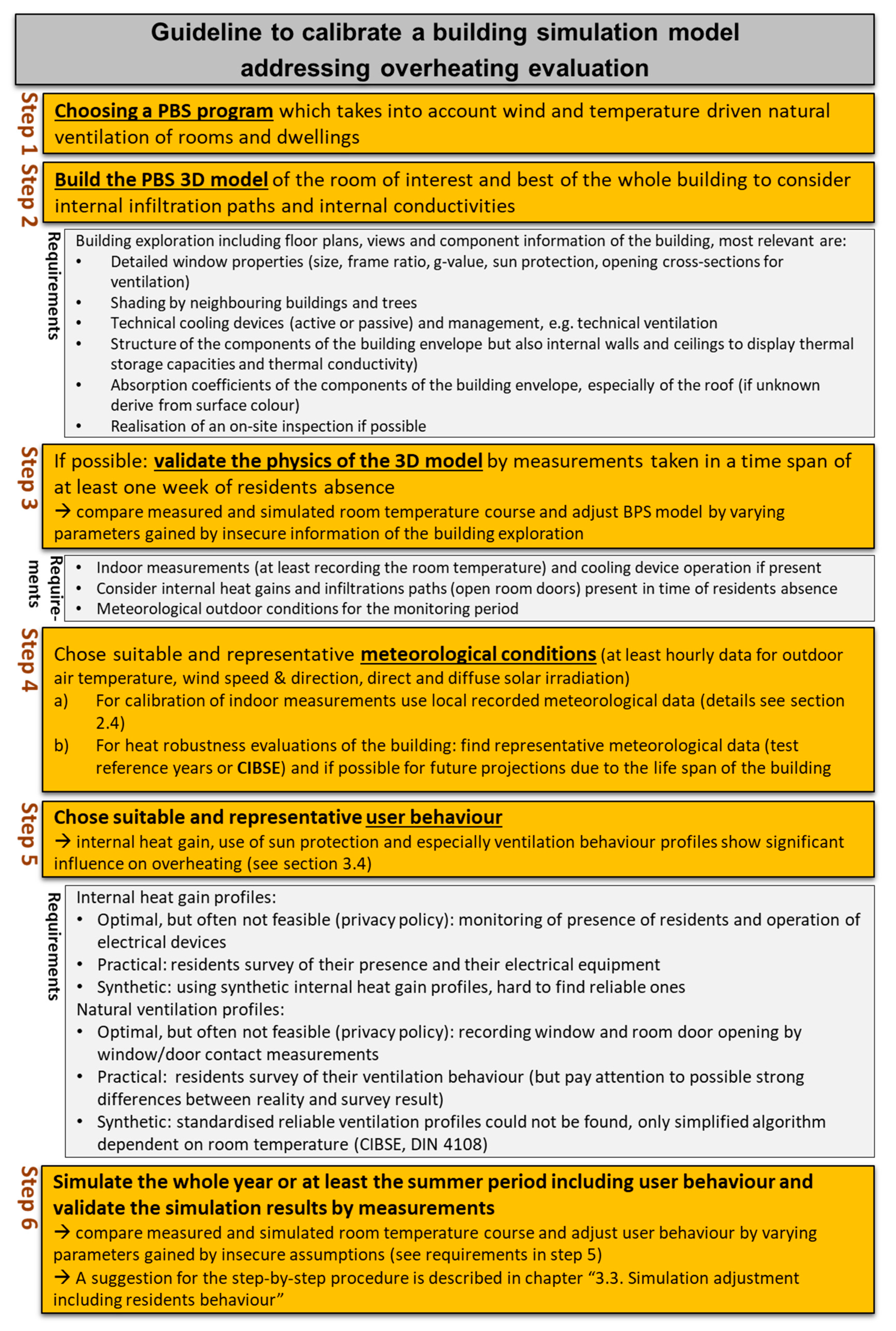
| Component | Construction | U-Value |
|---|---|---|
| Exterior walls * | 1st & 2nd floor: 51 cm brick walls | 0.84 W/(m2K) |
| 3rd & 4th floor: 38 cm brick walls | 1.10 W/(m2K) | |
| attic: 25 cm brick wall with 6 cm internal insulation | 0.43 W/(m2K) | |
| Interior walls | mainly 25 cm brick walls; some drywalls, in attic only drywalls | 1.6 W/(m2K) |
| 0.57 W/(m2K) | ||
| Basement ceiling | light concrete ceiling/6 cm insulation/5 cm screed/flooring | 0.48 W/(m2K) |
| Ceilings | suspended wooden beam ceilings/1 cm mineral wool/2 cm dry screed/flooring | 0.63 W/(m2K) |
| Roof ** | Saddle roof with 16 cm between-rafter mineral wool insulation and 2.5 cm plasterboard interior | 0.22 W/(m2K) |
| Windows | double insulation glazing (g = 0.60) | 1.8 W/(m2K) |
| Parameter | Erfurt City (GZH Building) | Environs of Erfurt (Airport) |
|---|---|---|
| Average outdoor air temperature | 21.1 °C | 19.6 °C |
| Maximum outdoor air temperature | 37.3 °C | 35.8 °C |
| Average wind speed (10 m height) | 2.0 m/s | 3.5 m/s |
| Maximum wind speed (10 m height) | 7.0 m/s | 13.6 m/s |
| Number of hot days (>30 °C) | 20 | 15 |
| Number of tropical nights (>20 °C) | 4 | 2 |
| Mean Room Temperature | Maximum Room Temperature | Overtemperature Degree Hours | RSME | |||||||||
|---|---|---|---|---|---|---|---|---|---|---|---|---|
| Floor Level | Room Orient. | Measured | Simulated | Difference | Measured | Simulated | Difference | Measured | Simulated | Difference | Room Temperature | Overtemp. Degree Hours |
| 1th | east | 24.8 °C | 24.8 °C | 0.0 °C | 28.1 °C | 28.0 °C | 0.1 °C | 300 Kh | 350 Kh | −50 Kh | 0.49 K | 0.21 Kh/a |
| west | 23.5 °C | 23.8 °C | −0.3 °C | 28.1 °C | 27.0 °C | 1.1 °C | 50 Kh | 60 Kh | −10 Kh | 0.60 K | 0.14 Kh/a | |
| 2th | east | 24.9 °C | 24.9 °C | 0.1 °C | 29.8 °C | 28.4 °C | 1.4 °C | 450 Kh | 440 Kh | 10 Kh | 0.74 K | 0.30 Kh/a |
| west | 23.7 °C | 23.6 °C | 0.1 °C | 29.8 °C | 28.2 °C | 1.6 °C | 240 Kh | 250 Kh | −10 Kh | 1.00 K | 0.34 Kh/a | |
| 4th | east | 24.2 °C | 24.6 °C | −0.4 °C | 29.4 °C | 29.3 °C | 0.1 °C | 330 Kh | 640 Kh | −310 Kh | 1.05 K | 0.50 Kh/a |
| west | 23.9 °C | 24.3 °C | −0.3 °C | 30.3 °C | 29.7 °C | 0.6 °C | 410 Kh | 550 Kh | −140 Kh | 1.08 K | 0.36 Kh/a | |
| 5th | east * | 26.2 °C | 26.2 °C | 0.1 °C | 30.7 °C | 31.2 °C | −0.5 °C | 1980 Kh | 2100 Kh | −120 Kh | 1.11 K | 0.71 Kh/a |
| west * | 26.8 °C | 26.7 °C | 0.1 °C | 31.8 °C | 32.4 °C | −0.6 °C | 3070 Kh | 2890 Kh | 180 Kh | 1.16 K | 0.87 Kh/a | |
| east ** | 25.5 °C | 25.0 °C | 0.5 °C | 30.6 °C | 31.7 °C | −1.1 °C | 1210 Kh | 1420 Kh | −210 Kh | 1.78 K | 0.70 Kh/a | |
| west ** | 27.0 °C | 26.4 °C | 0.5 °C | 36.7 °C | 33.8 °C | 3.0 °C | 3600 Kh | 2940 Kh | 660 Kh | 1.82 K | 1.09 Kh/a | |
| (a) Weather Data Input | (b) Shading Objects | (d) Window Ventilation | (e) Sun Protection | ||||||||||
|---|---|---|---|---|---|---|---|---|---|---|---|---|---|
| Floor Level | Room Orient. | Weather Erfurt city (District Oststadt) | Weather Environs of Erfurt (Airport) | Mixed Weather Data1 | Including All Shadings Present in Reality | No Shading Objects2 | No Shading by Trees | Low Window Opening (as Observed) | Optimised Window Night-Time Ventilation3 | Cross Ventilation and Optim. Window Ventilation | No Sun Protection for Top Floor Dwellings4 | On-Roof Mounted Photo-Voltaic Modules4 | External Sun Pro-Tection for Top Floor Dwellings |
| 1th | east | 300 Kh | 100 Kh | 100 Kh | 300 Kh | 1800 Kh | 700 Kh | 300 Kh | 900 Kh | 100 Kh | 400 Kh | 300 Kh | 300 Kh |
| west | 100 Kh | 0 Kh | 0 Kh | 100 Kh | 700 Kh | 300 Kh | 100 Kh | 0 Kh | 0 Kh | 100 Kh | 100 Kh | 100 Kh | |
| 4th | east | 600 Kh | 100 Kh | 100 Kh | 600 Kh | 1100 Kh | 700 Kh | 600 Kh | 100 Kh | 100 Kh | 100 Kh | 700 Kh | 500 Kh |
| west | 500 Kh | 100 Kh | 200 Kh | 500 Kh | 900 Kh | 600 Kh | 500 Kh | 400 Kh | 200 Kh | 700 Kh | 600 Kh | 500 Kh | |
| 5th | east * | 2100 Kh | 800 Kh | 1000 Kh | 2100 Kh | 2800 Kh | 2200 Kh | 2100 Kh | 600 Kh | 600 Kh | 3200 Kh | 2300 Kh | 1100 Kh |
| west * | 2900 Kh | 1100 Kh | 1,500 Kh | 2900 Kh | 3900 Kh | 3000 Kh | 2900 Kh | 1400 Kh | 900 Kh | 4500 Kh | 3100 Kh | 1700 Kh | |
| east ** | 1400 Kh | 600 Kh | 700 Kh | 1400 Kh | 1600 Kh | 1500 Kh | 1400 Kh | 900 Kh | 1000 Kh | 1600 Kh | 1100 Kh | 600 Kh | |
| west ** | 2900 Kh | 1500 Kh | 1700 Kh | 2900 Kh | 3200 Kh | 3000 Kh | 2900 Kh | 2200 Kh | 1700 Kh | 3100 Kh | 2200 Kh | 1300 Kh | |
Publisher’s Note: MDPI stays neutral with regard to jurisdictional claims in published maps and institutional affiliations. |
© 2021 by the authors. Licensee MDPI, Basel, Switzerland. This article is an open access article distributed under the terms and conditions of the Creative Commons Attribution (CC BY) license (https://creativecommons.org/licenses/by/4.0/).
Share and Cite
Schünemann, C.; Schiela, D.; Ortlepp, R. Guidelines to Calibrate a Multi-Residential Building Simulation Model Addressing Overheating Evaluation and Residents’ Influence. Buildings 2021, 11, 242. https://doi.org/10.3390/buildings11060242
Schünemann C, Schiela D, Ortlepp R. Guidelines to Calibrate a Multi-Residential Building Simulation Model Addressing Overheating Evaluation and Residents’ Influence. Buildings. 2021; 11(6):242. https://doi.org/10.3390/buildings11060242
Chicago/Turabian StyleSchünemann, Christoph, David Schiela, and Regine Ortlepp. 2021. "Guidelines to Calibrate a Multi-Residential Building Simulation Model Addressing Overheating Evaluation and Residents’ Influence" Buildings 11, no. 6: 242. https://doi.org/10.3390/buildings11060242
APA StyleSchünemann, C., Schiela, D., & Ortlepp, R. (2021). Guidelines to Calibrate a Multi-Residential Building Simulation Model Addressing Overheating Evaluation and Residents’ Influence. Buildings, 11(6), 242. https://doi.org/10.3390/buildings11060242





